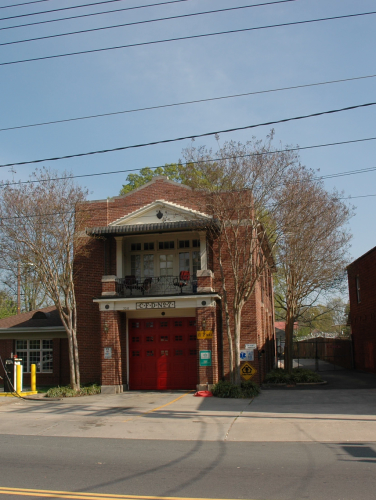
Charlotte Fire Station No. 7
(ca. 1935)
Charlotte Fire Station Number 7 is one of only three pre-World War II fire stations still in operation as firehouses in Charlotte, all designed by Charles Christian Hook.
3210 N. Davidson St., Charlotte, NC 28205
Starting as bucket brigades before evolving into firefighting companies, Charlotte’s first firefighters were all volunteers. By 1865, three volunteer companies served the city. Charlotte, like other growing industrial and commercial cities in the late 1800s, experienced a construction boom: new buildings clustered closely together, many soaring to unprecedented heights and constructed with highly combustible materials. Because such conditions put urban dwellers at risk, Charlotte needed a more systematic and reliable means to fight fires and prevent widespread destruction. Also, volunteer companies in Charlotte and throughout the country at that time were generally viewed as a "public menace" because many of their members were considered rowdy and ill-behaved.
Property Quick Links
Charlotte established its municipal Fire Department on August 1, 1887, after its volunteer firemen resigned over disagreements with the city. It was not until the late nineteenth century, after firefighters became municipal employees focused on saving lives rather than protecting property, that the heroic image of firemen as rescuers emerged. Many of the first municipal fire stations were grand brick structures lavishly decorated with stone carvings. It was hoped that such attractive living quarters would help with the recruitment of moral and civic-minded men to serve. City officials also opted for more aesthetically pleasing firehouses to placate suburbanites, many of whom became irate over the placement of institutional buildings in their upscale neighborhoods. Like many cities, Charlotte hired locally renowned architects to design municipal buildings as public art. As an example of the “storefront style” urban firehouse, Fire Station No. 7 demonstrates that sensitivity to the preexisting built environment. The station takes on the characteristics of the surrounding buildings within the commercial core of the North Charlotte mill village in terms of its scale, style, and construction materials. The presence of a jail cell in Station No. 7 is also reflective of its historically industrial neighborhood, as the textile workers who labored in the nearby Highland Park Manufacturing Plant No. 3, the Mercury Mill, and the Johnston Mill were known on occasion to get a bit rambunctious.
Charles Christian Hook (1870-1938) designed Station No. 7. A native of Wheeling, West Virginia and graduate of Washington University in St. Louis, Hook originally moved to Charlotte in 1891 to teach mechanical drawing in the city’s public schools. His plans soon changed as he became Charlotte’s first full-time professional architect. In total, Hook designed some 800 to 1,000 homes and buildings across the Carolinas, including Charlotte’s City Hall and federal courthouse, the Carolina Theater, Duke Mansion, Myers Park Elementary School, and several buildings on numerous North Carolina college campuses (including the Chapel Hill and Greensboro campuses of the University of North Carolina, Davidson College, N.C. State University, Duke University, Queens University, East Carolina University, and Guilford College). Station No. 7 is one of only three pre-World War Two Charlotte fire stations that continue to serve their original purpose. The other two – Fire Stations No. 5 (224 Wesley Heights Way) and No. 6 (249 South Laurel Avenue) – were also designed by Hook..
